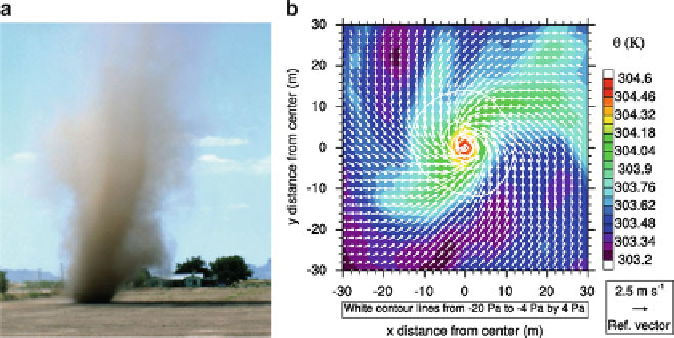Geoscience Reference
In-Depth Information
strongly suggest that they are a major contributor to dust generation over sum-
mertime northern Africa and that many (particularly smaller) events go unnoticed
due to the sparse observational network and cloud contamination in satellite data
(Marsham et al.
2011
; Heinold et al.
2013
; Kocha et al.
2013
). This is supported by
recent in-situ observations of the role of haboobs to dust uplift in the central Sahara
(Marsham et al.
2013a
). Another aspect of debate is wet deposition of dust particles
by convective rains (e.g. Takemi
2005
). Satellite imagery suggests that at least the
northern parts of many large dusty cold pools over the Sahara can move sufficiently
far away from the precipitation areas (Knippertz and Todd
2010
), consistent with
recent modelling work (Heinold et al.
2013
).
6.5
Dry Convection
Turbulent circulations in the dry convective daytime PBL over deserts during
summertime can cause considerable dust emission over mostly bare dry lands on
days with high insolation and weak background winds (Sinclair
1969
; Balme and
Greeley
2006
). These can take the form of more compact rotating dust devils
(typically 10 m in diameter persisting for a few minutes; Fig.
6.8
a) and larger,
longer-lived non-rotating dusty plumes (typically 100 m in diameter persisting for
up to an hour; Koch and Renno
2005
). Due to their short lifetime and small scale, as
well as logistical problems, systematic observation of these features is a challenge.
Consequently, it is not surprising that the majority of studies concentrate on more
accessible arid areas in North America (Sinclair
1964
; Ryan and Carroll
1970
;
Ryan
1972
; Snow and McClelland
1990
; Balme et al.
2003
; Renno et al.
2004
),
Fig. 6.8
(
a
) Photograph of a dust devil in Eloy, Arizona (Fig. 1c from Balme and Greeley
2006
).
(
b
) Horizontal distribution of potential temperature (
shading
), perturbation pressure (
contours
)and
the horizontal component of wind vectors (
arrows
) at 1 m above ground using 2 m grid spacing
(Fig. 8a from Raasch and Franke
2011
)

Search WWH ::

Custom Search